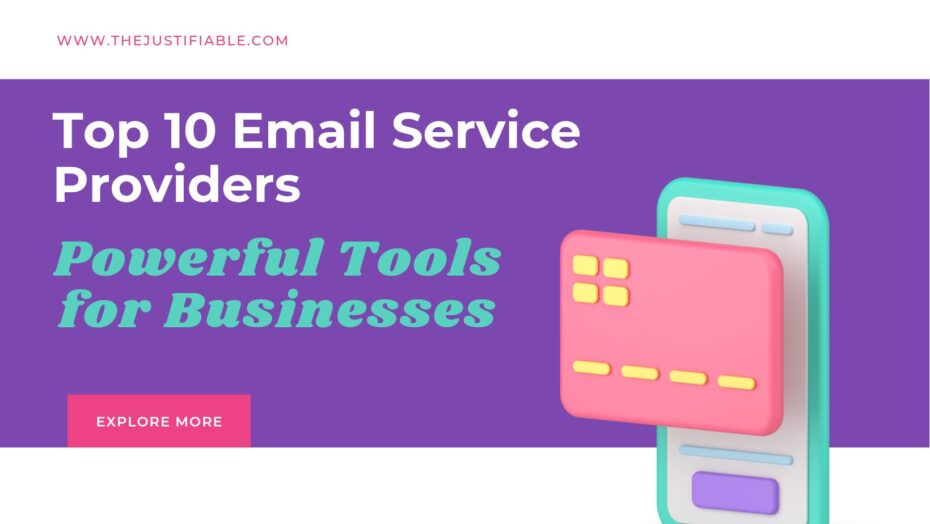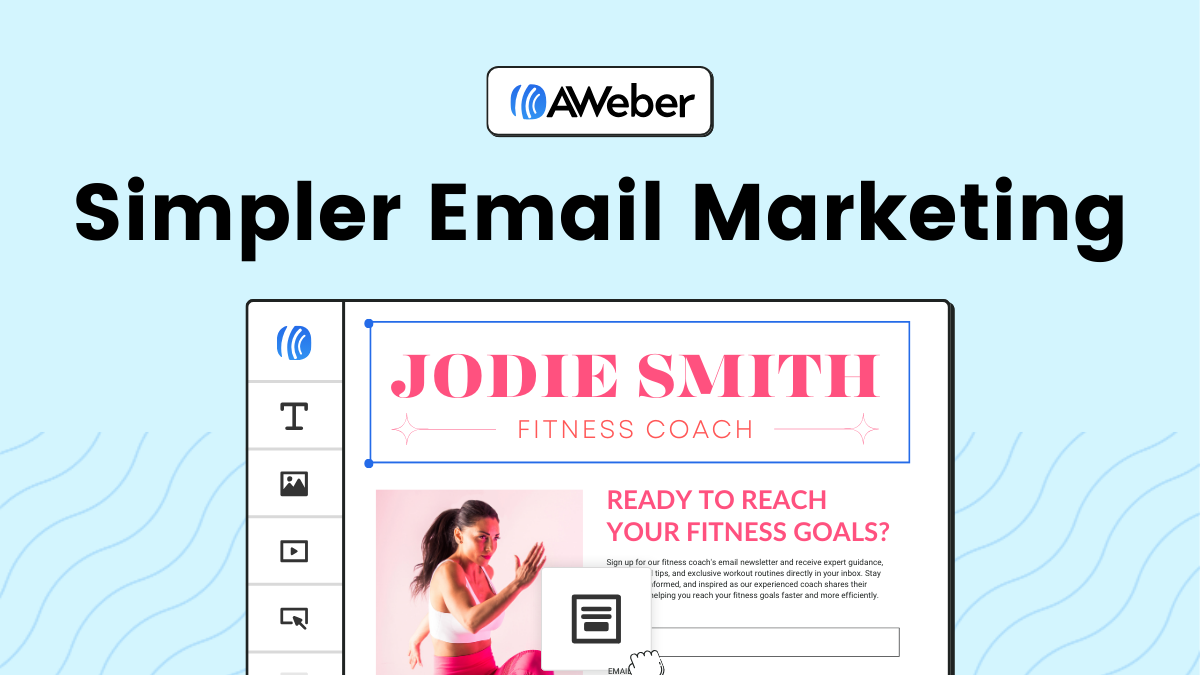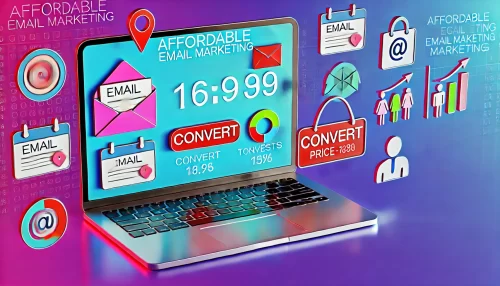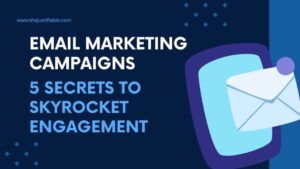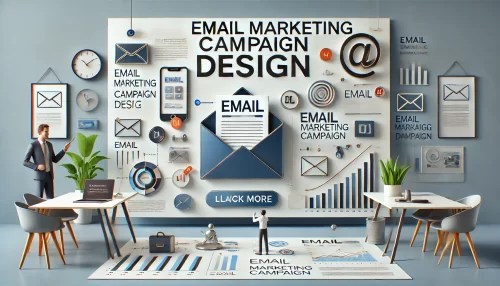Table of Contents
In the age of digital connectivity, the significance of communicating effectively cannot be overstated. For businesses, this means reaching out to their audience through multiple channels, and one of the most potent of these channels is email.
This brings us to the crucial role an email service provider plays. As businesses increasingly recognize the power of email marketing, the choice of the right provider becomes paramount.
The Growing Importance of Email Marketing
Email marketing isn’t a novel concept. It’s been around since the dawn of the internet, but its importance has only surged in recent times. Despite the proliferation of social media platforms and instant messaging apps, email remains a formal and professional mode of communication, trusted by businesses and customers alike. Its direct approach allows businesses to nurture their relationships with clients and stakeholders.
More than just a communication tool, email marketing has evolved to serve multiple purposes. From newsletters that keep stakeholders informed to promotional campaigns that drive sales, the applications are vast. Moreover, with people checking their emails multiple times a day, businesses have an unparalleled opportunity to connect with their audience frequently.
However, the effectiveness of an email marketing campaign doesn’t merely depend on the content. It hinges largely on the email service provider chosen. Which brings us to the next significant point: how does one select the ideal ESP for their needs?
Selecting the Right Email Service Provider (ESP)
The selection of an email service provider is akin to choosing a trusted partner for your business. It’s not about which provider has the most features, but which aligns best with your business objectives and operational requirements.
Firstly, deliverability is key. The most beautifully crafted email is of no use if it lands in the recipient’s spam folder. So, the ESP’s reputation in ensuring high deliverability rates should be of paramount concern.
Then comes the ease of use. For businesses starting out with email marketing, a steep learning curve is the last thing they need. An intuitive interface, paired with robust customer support, can make the transition smooth.
Scalability is another vital factor. As your business grows, so will your email marketing needs. Opting for an email service provider that can cater to both small and large-scale operations ensures you won’t have to switch providers later on, saving both time and resources.
Understanding Email Service Providers
In the ever-evolving digital landscape, the term “email service provider” (ESP) often comes up, especially in the context of effective business communication. But what does it encompass? And why is it so crucial for modern businesses? Let’s dive into these queries.
What is an Email Service Provider?
An email service provider, commonly abbreviated as ESP, is not merely a platform that lets you send and receive emails. It’s far more specialized than your typical Gmail or Yahoo Mail.
An ESP offers services that enable businesses to manage, send, and track bulk emails to a list of subscribers or potential customers. This includes newsletters, promotional campaigns, and other forms of business communication.
While the basic premise might sound simple – sending out emails in bulk – the functionality behind an ESP is intricate. It is designed to handle vast amounts of data, ensuring that each recipient on your list receives the email crafted specifically for them, at the right time, and in a format that’s compatible with their device.
Moreover, an ESP provides tools to segment and customize these emails, so a business can target specific groups within their audience more effectively. This is not something a standard email platform is equipped to do, hence the need for specialized providers in the market.
Benefits of Using a Professional ESP for Business
The decision to transition from conventional email platforms to a professional ESP is not just about sending out emails more efficiently; it’s a strategic move that can have numerous benefits for a business.
For one, email service providers significantly enhance deliverability. If you’ve ever tried sending out a massive number of emails from a regular account, you might have encountered issues. These can range from emails ending up in the spam folder to getting your account temporarily blocked. ESPs, with their reputation and established networks, ensure that your emails land in the recipient’s inbox.
Furthermore, the analytical tools provided by ESPs are game-changers. They provide insights into how your emails are performing, from open rates to click-through rates, and even how long recipients spend reading your content. This data is invaluable for businesses aiming to refine their strategies and maximize the impact of their campaigns.
Lastly, scalability and integration are also crucial benefits. As your business expands, your email marketing needs will grow too. ESPs are designed to handle this growth seamlessly, ensuring that whether you have a hundred subscribers or a hundred thousand, your emails go out without a hitch. Additionally, many ESPs can be integrated with other marketing tools and platforms, offering a holistic approach to digital marketing.
Top 10 Email Service Providers for Businesses
Navigating the digital realm of email marketing can be daunting, especially with a plethora of choices at your fingertips. However, the right email service provider can be a game-changer, transforming your business communication strategies and driving customer engagement. Let’s focus on two giants in the email service provider sector that have continuously proven their mettle.
1. Mailchimp: A Market Leader In Email Solutions
In the vast expanse of email marketing solutions, Mailchimp stands out as a titan. Launched in 2001, it’s not only one of the oldest but also one of the most trusted email service providers in the market. But what makes Mailchimp such a favorite among businesses?
For starters, Mailchimp offers an exceptionally user-friendly interface. Even if you’re new to the realm of email marketing, their platform guides you smoothly through every process. From crafting beautiful emails without knowing a line of code to segmenting your audience based on behavior, location, or preferences, Mailchimp offers tools that simplify complex tasks.
Another distinctive feature is their robust analytics. With Mailchimp, businesses aren’t just sending emails into the void. They’re equipped with detailed reports on open rates, click-through rates, and audience engagement metrics. This data-driven approach helps businesses refine their strategies and tailor their content for optimal impact.
Moreover, Mailchimp is not just an email service provider anymore. Over the years, they have expanded their offerings to include landing pages, social media ads, and even postcards. This holistic approach to marketing ensures that businesses have a unified platform for various outreach strategies.
2. Getresponse: Beyond Simple Email Campaigns
While Mailchimp may be a household name, Getresponse has carved its niche, especially among businesses looking for more than just email marketing solutions. Founded in 1998, Getresponse has been a silent force, constantly innovating and adapting to the evolving needs of digital marketers.
What sets Getresponse apart? For one, it boasts a comprehensive suite of marketing tools. Beyond traditional email campaigns, it offers webinar hosting, a feature not commonly found in typical email service providers. This addition showcases Getresponse’s understanding of the modern business landscape, where webinars have become an integral part of customer engagement and education.
Furthermore, Getresponse is lauded for its marketing automation tools. These tools allow businesses to craft customer journeys based on behaviors and actions. For instance, if a customer abandons a cart, an automated email sequence can be triggered, nudging the customer to complete the purchase. This level of automation, paired with detailed analytics, ensures businesses can optimize their strategies on the go.
3. Aweber: User-Friendly Email Marketing Tool
In the world of email service providers, Aweber has solidified its reputation as one of the pioneers. Established in 1998, it has consistently focused on providing businesses of all sizes with straightforward email marketing tools, ensuring that even those with minimal technical know-how can navigate the platform with ease.
Aweber shines in its commitment to simplicity without compromising functionality. The drag-and-drop email editor, for instance, is a testament to this ethos. Users can design visually appealing emails, complete with images, buttons, and even videos, without wrestling with complex coding. The templates provided are not only numerous but also optimized for mobile devices, ensuring emails look great regardless of where they’re viewed.
Beyond design, Aweber also offers robust list management tools. Segmentation becomes a breeze, allowing businesses to tailor their campaigns to specific portions of their audience based on behavior, purchase history, or even geographical location.
Another standout feature of Aweber is its customer support. Recognizing that even the most intuitive platforms can pose challenges, they offer 24/7 assistance, ensuring users have a helping hand whenever needed. For many businesses, this commitment to user support makes Aweber not just an email service provider but a trusted partner in their marketing journey.
4. Omnisend: Integrating E-Commerce With Email Marketing
In the bustling world of online retail, email marketing plays a pivotal role, and this is where Omnisend comes into the picture. Tailored explicitly for e-commerce businesses, Omnisend bridges the gap between traditional email marketing and the unique needs of online sellers.
Omnisend’s strength lies in its understanding of e-commerce dynamics. It’s not just about sending emails; it’s about crafting campaigns that drive sales. With features like product recommendation emails based on browsing behavior or abandoned cart sequences, Omnisend ensures that potential sales aren’t left on the table.
Moreover, its seamless integration with popular e-commerce platforms like Shopify, Magento, and WooCommerce means that businesses can synchronize their store data effortlessly. This integration provides real-time insights into customer behavior, from products viewed to items added to the cart, allowing for hyper-targeted marketing campaigns.
But Omnisend isn’t restricted to just email. Recognizing the importance of multi-channel marketing in today’s digital age, it also supports SMS, push notifications, and even Facebook Messenger campaigns. This multi-pronged approach ensures that businesses can reach their customers wherever they are, amplifying their marketing efforts.
5. Maropost: Advanced Digital Marketing Automation
Amid the sea of email marketing tools, Maropost emerges as a behemoth, particularly in the realm of advanced marketing automation. Established with the aim to simplify complex marketing processes, Maropost has grown exponentially, supporting businesses as they navigate the multifaceted digital landscape.
One of Maropost’s standout features is its unified customer view. Instead of businesses having to juggle multiple platforms and data points, Maropost consolidates all customer interactions into a single, cohesive view. This offers marketers a holistic understanding of customer behavior, from email interactions to website visits, ensuring campaigns are crafted with precision.
But what truly sets Maropost apart is its automation capabilities. Beyond just setting up automated email sequences, Maropost allows for intricate customer journey mapping. Depending on a user’s actions or inactions, tailored content is delivered, ensuring that the marketing messages are not just relevant but timely. This level of personalization often translates to higher engagement rates and, ultimately, conversions.
Additionally, Maropost’s commitment to deliverability is noteworthy. In the world of email marketing, ensuring emails reach the intended inbox is half the battle. With advanced analytics and deliverability tools, Maropost guarantees that businesses’ messages aren’t just sent, but they are seen.
6. Mailmunch: Simplified Lead Capturing
In the initial stages of customer acquisition, capturing leads is paramount. Enter Mailmunch, an email service provider designed with a focus on lead generation. While it offers the usual suite of email marketing tools, its real strength lies in its ability to simplify the process of collecting and nurturing potential customer data.
Mailmunch shines brightest with its array of lead capture tools. From pop-ups to embedded forms, businesses can design visually appealing and optimized lead capture methods without delving into intricate coding. These forms are not just easy to set up but also optimized for conversions, ensuring businesses have the best shot at expanding their email lists.
Moreover, the platform offers a seamless way to segment and nurture these leads. Based on the data collected, businesses can tailor their subsequent communications, ensuring potential customers receive content that resonates with their interests and needs.
7. MailPoet: WordPress-Native Email Management
When it comes to harnessing the power of WordPress for email marketing, few tools resonate as effectively as MailPoet. Tailored specifically for the WordPress platform, MailPoet offers a seamless integration, bridging the gap between website content and email campaigns.
What makes MailPoet unique is its innate understanding of the WordPress environment. Users can craft and send newsletters directly from their WordPress dashboard. This tight-knit integration means that content, be it recent blog posts or special announcements, can be easily transitioned into email format without the hassle of swapping between platforms.
Furthermore, MailPoet offers a wide range of beautifully crafted templates. Given WordPress’s strong focus on aesthetics and user experience, having an email tool that echoes this commitment ensures a consistent brand image across all customer touchpoints.
But it’s not just about sending emails. MailPoet also provides detailed insights right within the WordPress dashboard. From tracking open rates to monitoring click-throughs, businesses can gauge the efficacy of their campaigns without leaving the familiar environment of their website backend.
8. WP Mail SMTP: Enhancing WordPress Email Deliverability
While crafting compelling emails is one part of the puzzle, ensuring they reach the intended inboxes is equally critical. For WordPress users, WP Mail SMTP emerges as a quintessential tool, specifically designed to boost email deliverability from the platform.
The primary challenge that WP Mail SMTP addresses is the inherent limitation of WordPress’s PHP mail function, which can often result in emails landing in spam folders or not being delivered at all. WP Mail SMTP rectifies this by allowing users to send WordPress emails using an SMTP server, dramatically improving the chances of successful email delivery.
Setup is straightforward, and the plugin integrates seamlessly with a host of popular SMTP providers, including Gmail, SendGrid, and Mailgun. This flexibility ensures that businesses can choose a provider that aligns with their needs and budget.
Moreover, WP Mail SMTP isn’t just about deliverability; it’s also about transparency. The plugin offers detailed email logs, allowing users to track every email sent from their WordPress site. This feature proves invaluable in troubleshooting or simply understanding email activity over time.
9. Mailbird Pro: Merging Email Management And Productivity
In an era where the lines between email communication and productivity tools often blur, Mailbird Pro emerges as a solution that understands this synergy. At its core, Mailbird Pro is more than just an email client; it’s a hub for managing communications, tasks, and more, all from a single dashboard.
The standout feature of Mailbird Pro is its integration prowess. It seamlessly connects with a myriad of popular apps, from messaging platforms like WhatsApp and Slack to task management tools such as Trello or Todoist. This means that while checking emails, users can simultaneously manage their tasks, appointments, and even social media without switching between different applications.
Mailbird Pro’s unified inbox is another noteworthy feature. For those juggling multiple email accounts, be it for work, personal use, or specific projects, the unified inbox brings all communications into a single stream. This consolidation not only streamlines email management but also ensures that no message goes unnoticed.
Furthermore, the platform boasts an intuitive interface, complete with customization options to suit individual preferences. From color themes to layout choices, Mailbird Pro offers a tailored email experience, ensuring users feel at home while managing their communications.
10. Moosend: Cost-Effective Marketing Automation
In the competitive arena of email marketing, businesses often grapple with balancing functionality and budget. Moosend emerges as a solution to this dilemma, offering top-tier marketing automation features without breaking the bank.
Moosend’s drag-and-drop email editor is a testament to its user-centric approach. Even those without a design background can craft visually compelling emails that resonate with their audience. Additionally, with a library of responsive templates at their disposal, businesses can ensure their emails look impeccable across devices.
But where Moosend truly shines is its automation workflows. With an intuitive visual builder, businesses can set up automated sequences, from welcome emails to re-engagement campaigns. These workflows can be as simple or as intricate as needed, allowing for tailored customer journeys based on behavior, preferences, or past interactions.
Another commendable aspect of Moosend is its segmentation capabilities. Businesses can slice and dice their email lists based on a plethora of criteria, ensuring each subscriber receives content that’s relevant and engaging.
Lastly, Moosend’s commitment to affordability doesn’t compromise its reporting capabilities. The platform offers in-depth analytics, from open rates and click-through metrics to geographic insights, ensuring businesses have a clear understanding of their campaign performance.
Key Features to Consider When Choosing an Email Service Provider
In today’s digital age, email marketing remains a pivotal tool for businesses, driving engagement, sales, and customer loyalty. However, the success of your email campaigns heavily relies on the email service provider (ESP) you choose.
Not all ESPs are created equal, and understanding the nuances of their offerings can be the key to unlocking your campaign’s potential. Here, we explore some fundamental features that can make all the difference.
Deliverability Rates
The term “deliverability” often echoes in the corridors of email marketing. And for a good reason. What’s the point of crafting a compelling email if it doesn’t land in the recipient’s primary inbox, or worse, if it ends up in the spam folder? Deliverability rates, therefore, are pivotal in evaluating the effectiveness of an email service provider.
At its core, deliverability rates represent the percentage of emails that successfully reach the recipient’s inbox, undeterred by spam filters or other barriers. It’s the first metric businesses should consider when choosing an ESP because high deliverability rates translate to more eyes on your content, increasing chances of engagement and conversion.
Several factors contribute to an ESP’s deliverability rate. From the reputation of their sending servers to the relationships they maintain with major internet service providers and email services, an ESP’s commitment to ensuring emails land in the inbox is a testament to their prowess.
Additionally, ESPs that provide tools for email authentication, regular list cleaning, and spam testing can significantly boost deliverability.
Template and Design Flexibility
Email marketing isn’t just about sending information; it’s about communicating a brand story, engaging users, and driving action. And much of this communication is visual. Hence, the template and design flexibility offered by an ESP can be a game-changer.
Today’s audiences have an acute sense of design aesthetics, thanks to the proliferation of visually rich digital content. Sending out plain, unattractive emails can deter engagement and even tarnish brand perception. Thus, an ESP’s ability to offer diverse, customizable, and responsive templates becomes crucial.
But it’s not just about aesthetics. The ease of use is equally vital. ESPs that offer intuitive drag-and-drop editors can simplify the email creation process, ensuring businesses, regardless of their design expertise, can craft visually compelling emails with ease.
Moreover, the flexibility to customize templates, from color schemes and fonts to the placement of call-to-action buttons, allows businesses to ensure brand consistency across campaigns. An email is often a customer’s first interaction with a brand; hence, ensuring it resonates with the brand’s identity is essential.
Furthermore, given the diversity of devices audiences use to access emails – from desktops and laptops to tablets and smartphones – ensuring the email template is responsive becomes paramount. ESPs that automatically adjust the email layout based on the recipient’s device ensure a seamless user experience, increasing the chances of engagement.
Automation Capabilities
The modern digital landscape demands more than just periodic email blasts. Instead, timely, relevant, and personalized communication stands at the forefront, and automation is the key to achieving this. When evaluating an email service provider, its automation capabilities can significantly influence the efficacy of your campaigns.
Email automation transcends traditional marketing, allowing businesses to set up trigger-based emails that cater to the specific behaviors or actions of subscribers. Be it a welcome series for new subscribers, a birthday discount, or a follow-up email for abandoned carts, automation ensures that the right message reaches the right person at the right time.
But it’s not just about sending automated emails; it’s about crafting intricate customer journeys. Leading ESPs empower users to design workflows that cater to diverse audience segments, nurturing leads and driving conversions with minimal manual intervention. For instance, a subscriber who clicks on a product link in an email might receive a tailored follow-up, while another who ignores the email might be retargeted differently.
Analytics and Reporting Tools
While crafting and sending emails is a significant part of email marketing, understanding their impact is equally critical. Without robust analytics and reporting tools, businesses fly blind, uncertain about what’s working and what needs adjustment.
A potent email service provider will not only provide insights into basic metrics like open rates, click-through rates, and bounce rates but will delve deeper, offering granular data on subscriber behavior. This might include which links were clicked, the devices and browsers used, the best times for engagement, and even geographic insights.
Such in-depth analysis allows businesses to refine their strategies. For instance, if a particular subject line sees higher open rates, it indicates a winning formula that can be replicated. Similarly, if a segment of subscribers consistently engages with content related to a specific product category, future campaigns can be tailored to cater to their interests.
Furthermore, visual dashboards that consolidate these insights can be invaluable. They provide a snapshot of campaign performance, making it easier for businesses to draw correlations, identify trends, and make informed decisions.
Integration with Other Tools
In an interconnected digital ecosystem, email marketing doesn’t operate in isolation. It often needs to work in tandem with other tools, be it CRM systems, e-commerce platforms, or social media channels. Hence, the ability of an email service provider to seamlessly integrate with other tools can be a decisive factor for businesses.
Such integrations amplify the power of email marketing. For instance, integrating with a CRM might allow businesses to tap into detailed customer profiles, sending emails based on purchase history or past interactions. Similarly, integration with e-commerce platforms can facilitate automated emails for product recommendations, reviews, or restock alerts.
Moreover, as businesses employ a myriad of tools for various functions, from lead capture and customer support to project management, an ESP’s compatibility ensures that data flows seamlessly across platforms. This not only simplifies operations but also creates a cohesive customer experience.
User Experience and Support: Vital Aspects of an Effective Email Service Provider
The technical features of an email service provider are undeniably important. However, without an intuitive user experience and reliable support, even the most feature-rich platform can fall short of its potential. Understanding the user interface’s fluidity and the quality of customer support is pivotal when businesses commit to an ESP.
Intuitive User Interface
In the ever-evolving world of digital marketing, time is of the essence. Marketers often juggle multiple tasks, from content creation and campaign planning to analytics and reporting. An email service provider with a cluttered or complex interface can impede these processes, resulting in inefficiencies and potential errors.
An intuitive user interface, on the other hand, simplifies the email marketing process. Features like drag-and-drop editors, clear navigation menus, and streamlined workflow builders can significantly reduce the learning curve, allowing even those new to email marketing to craft and execute effective campaigns.
Moreover, a well-designed user interface often reflects the platform’s overall quality, indicating that the developers prioritize the end-user’s experience. It’s also worth noting that a user-friendly interface can reduce dependency on customer support, as users can naturally find their way around without constant guidance.
Responsive Customer Support
While an intuitive platform can minimize issues, questions or challenges are inevitable in the realm of email marketing. Whether it’s a deliverability concern, integration hiccup, or a feature-related query, having a reliable customer support team can make all the difference.
The responsiveness and expertise of an ESP’s support team can influence a business’s email marketing success. Rapid resolutions ensure that campaigns aren’t delayed, and knowledgeable support staff can provide insights that enhance overall strategy.
Various support channels, from live chats and phone support to comprehensive knowledge bases or community forums, cater to different user preferences. However, the consistency in quality across these channels is what truly sets an ESP apart. For many businesses, especially those new to email marketing, a supportive and proactive customer service team can be the deciding factor when choosing between providers.
Ongoing Training and Resources
Beyond the immediate support, leading email service providers often invest in their user community’s growth. Offering resources like webinars, tutorials, case studies, and best practice guides indicates a commitment to user success. These resources not only help users make the most of the platform but also enhance their overall email marketing acumen.
When evaluating ESPs, businesses should consider the depth and breadth of these resources. Continuous learning opportunities can significantly influence campaign results, driving better engagement, conversion, and ROI.


